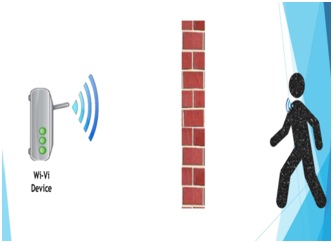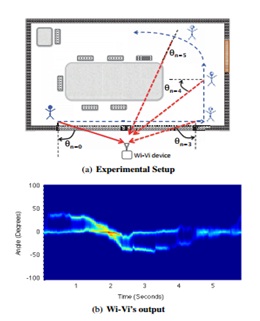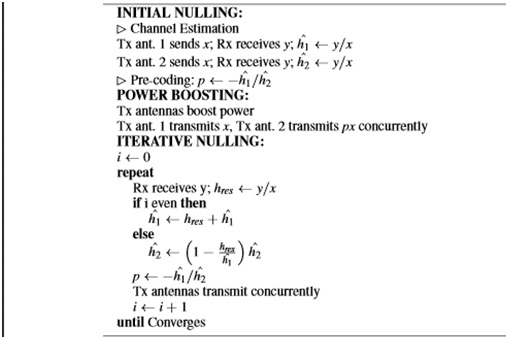





Published on Feb 14, 2025
Can Wi-Fi signals enable us to see through walls? For many years humans have fantasized about X-ray vision and played with the concept in comic books and sci-fi movies. This paper explores the potential of using Wi-Fi signals and recent advances in MIMO communications to build a device that can capture the motion of humans behind a wall and in closed rooms.
Law enforcement personnel can use the device to avoid walking into an ambush, and minimize casualties in standoffs and hostage situations. Emergency responders can use it to see through rubble and collapsed structures. Ordinary users can leverage the device for gaming, intrusion detection, privacy-enhanced monitoring of children and elderly, or personal security when stepping into dark alleys and unknown places
WI-VI is Based on the principle of RADAR and SONAR imaging(doppler effect). RADAR is an object detection system which uses radio waves to determine the range, altitude, direction, or speed of objects. It’s similar to the way radar and sonar work but without the expensive ,bulky gear and restricted frequencies that radar requires. Depends on its own transmitting signal.
The concept underlying seeing through opaque obstacles is similar to radar and sonar imaging. Specifically, when faced with a non-metallic wall, a fraction of the RF signal would traverse the wall, reflect off objects and humans, and come back imprinted with a signature of what is inside a closed room.signal power after traversing the wall twice (in and out of the room) is reduced by three to five orders of magnitude . Even more challenging are the reflections from the wall itself, which are much stronger than the reflections from objects inside the room . Reflections off the wall overwhelm the receiver’s analog to digital converter (ADC), preventing it from registering the minute variations due to reflections from objects behind the wall. This behavior is called the “Flash Effect" since it is analogous to how a mirror in front of a camera reflects the camera’s flash and prevents it from capturing objects in the scene. So how can one overcome thesedifficulties? The radar community has been investigating these issues, and has recently introduced a few ultra-wideband systems that can detect humans moving behind a wall, and show them as blobs moving in a dim background .

Wi-Vi shares the objectives of these devices; however, it introduces a new approach for eliminating the flash effect without wideband trans-mission. This enables it to work with concrete walls and solid wood doors, as well as fully closed rooms. The only attempt which we are aware of that uses Wi-Fi signals in order to see through walls was made in . This system required both the transmitter and a reference receiver to be inside the imaged room.
Furthermore, the reference receiver in the room has to be connected to the same clock as the receiver outside the room. In contrast, Wi-Vi can perform through-wall imaging without access to any device on the other side of the wall.
Wi-Vi uses interference nulling to cancel both the wall reflections and the direct signal from the transmit to the receive antenna. To eliminate flash, a sample x is transmitted on each transmit antenna separately and the ratio p is calculated. Then x and px are transmitted concurrently to get the perceived channel at the receiver. The process repeats until channel estimates in step1 are perfect so that the received signal is zero.
This is a demonstration of the technology that makes use of Wi-Fi to let the users ‘see’ a person moving behind a wall.

Fig3.2.1.1:Tracking A Person’s Movements
The name is a combination of Wi-Fi and vision; get that? Wi and Vi combined! It has been proven that delicate reflections of wireless inter signals that bounce off a human can be used to track the person’s movements. However,these methods were tiresome and required either a Wi-Fi router in the same room as the person or as Professor Katabi puts it; ‘a whole truck just to carry the radio’.
Now that we have eliminated the impact of static objects in the environment, we can focus on tracking moving objects. We will refer to moving objects as humans since they are the primary subjects of interest for our application; however, our system is general, and can capture other moving bodies. Below, we first explain how Wi-Vi tracks the motion of a single human. We then show how to extend our approach to track multiple moving humans. Tracking a Single Human Most prior through-wall systems track human motion using an antenna array. They steer the array’s beam to determine the direction of maximum energy. This direction corresponds to the signal’s spatial angle of arrival. By tracking that angle in time, they infer how the object moves in space.
Wi-Vi, however, avoids using an antenna array for two reasons: First, in order to obtain a narrow beam and hence achieve a good resolution, one needs a large antenna array with many antenna elements. This would result in a bulky and expensive device. Second, since Wi-Vi eliminates the flash effect using MIMO nulling, adding multiple receive antennas would require nulling the signal at each of them. This would require adding more transmit antennas, thus making the device even bulkier and more expensive. To capture the benefits of an antenna array while avoiding its drawbacks, Wi-Vi leverages a technique called inverse synthetic aperture radar (ISAR). ISAR exploits the movement of the target to emulate an antenna array. Existing systems which use antenna arrays capture the signal reflected off a target from spatially spaced antennas and processes this information to identify the direction of the target with respect to the array. In contrast, in ISAR, there is only one receive antenna; hence, at any point in time, the receiver captures a single measurement.
In this section, we show how Wi-Vi extends its tracking procedure to multiple humans. Our previous discussion about using human motion to emulate an antenna array still holds. However, each human will emulate a separate antenna array. Since Wi-Vi has a single antenna, the received signal will be a superposition of the antenna arrays of the moving humans. In particular, instead of having one curved line at any time, there will be as many curved lines as moving humans at that point in time.
However, with multiple humans, the noise increases significantly. On one hand, each human is not just one object because of different body parts moving in a loosely coupled way. On the other hand, the signal reflected off all of these humans is correlated in time, since they all reflect the transmitted signal.The lack of independence between the reflected signals is important. For example, the reflections of two humans may combine systematically to dim each other over some period of time.

Fig3.2.2.1:Experimental Setup
The problem of disentangling correlated super-imposed signals is well studied in signal processing. The basic approach for processing such signals relies on the smoothed MUSIC algorithm. Similar to the standard antenna array processing, smoothed MUSIC computes the power received along a particular direction, which we call A! [θ, n] because it estimates the same function in but in manner more resilient to noise and correlated signals. For a given antenna array h = (h[n], ... , h[n + w]) of size w, MUSIC first computes the w × w correlation matrix R[n]: R[n] = E[hhH], where H refers to the hermitian (conjugate transpose) of the vector. It then performs an eigen decomposition of R[n] to remove the noise and keep the strongest eigenvectors, which in our case correspond to the few moving humans, as well as the DC value.
For example, in the presence of only one human, MUSIC would produce one main eigenvector (in addition to the DC eigenvector). On the other hand, if 2 or 3 humans were present, it would discover 2 or 3 eigenvectors with large eigen values (in addition to the DC eigenvector). MUSIC partitions the eigenvector matrix U[n] into 2 subspaces: the signal space US[n] and the noise space UN[n], where the signal space is the span of the signal eigenvectors, and the noise space is the span of the noise eigenvectors. MUSIC then projects all directions θ on the null space, then takes the inverse. This causes the θ’s corresponding to the real signals (i.e., moving humans) to spike.

High quality images. Future Scope Evolution of seeing humans through denser building material and with a longer range. Wi-Vi could be built into a Smartphone or a special handheld device. Wi-Vi, a wireless technology that uses Wi-Fi signals to detect moving humans behind walls and in closed rooms. In contrast to previous systems, which are targeted for the military, Wi-Vi enables small cheap see-through-wall devices that operate in the ISM band, rendering them feasible to the general public, without carrying any transmitting device.
• Wi-vi could be built in a smartphone or special handheld devices.
• Evolution of seeing human beings through denser building material with longer range.
• High quality images
• Published in: International Journal Of Advance Research in Science and Engineering(IJARSE)
Date of Conference: September 2013
Serial Id: ISSN-2319-8354(E)
Publisher: IEEE
• Seeing through walls - MIT’s Lincoln Laboratory. https://www.youtube.com/watch?v=H5xmo7iJ7KA
| Are you interested in this topic.Then mail to us immediately to get the full report.
email :- contactv2@gmail.com |